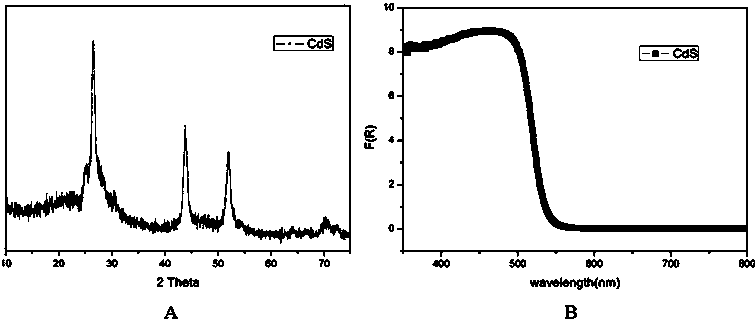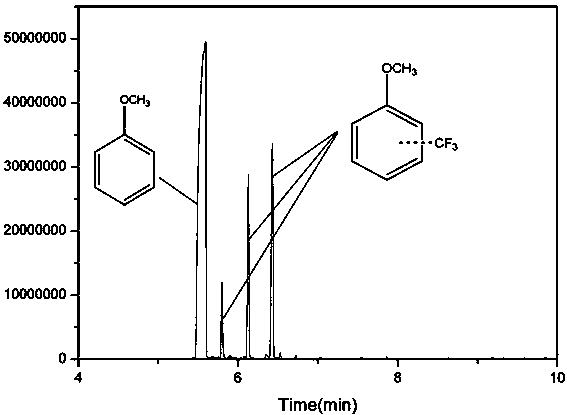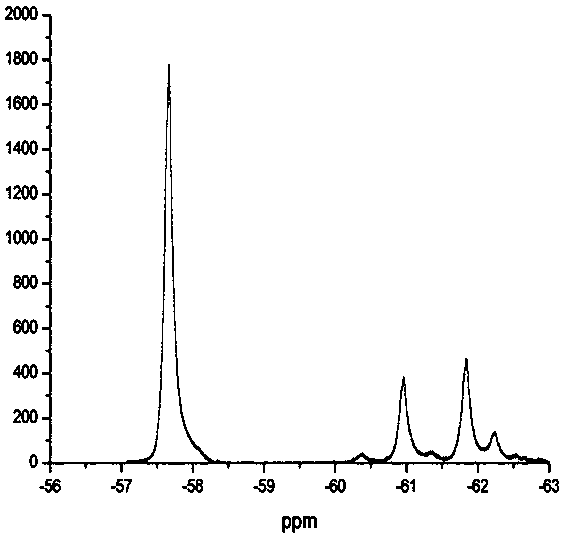A method for the trifluoromethylation of aromatics or heterocyclic aromatics catalyzed by semiconductors
A technology for trifluoromethylation and heterocyclic aromatic hydrocarbons, applied in the directions of organic chemistry methods, chemical instruments and methods, preparation of organic compounds, etc. Separation and other problems, to achieve the effect of cheap raw materials, easy separation, and easy availability of raw materials
- Summary
- Abstract
- Description
- Claims
- Application Information
AI Technical Summary
Problems solved by technology
Method used
Image
Examples
Embodiment 1
[0031] Example 1 Preparation of semiconductor photocatalyst α-CdS
[0032] Its preparation method comprises the following steps:
[0033] 1) Dissolve 2-5 mmol (preferably 2 mmol) of cadmium acetate in 100-500 mL (preferably 100 mL) of deionized water, stir well to dissolve;
[0034] 2) Dissolve 3-7 mmol (preferably 3 mmol) of sodium sulfide in 100-500 mL (preferably 150 mL) of deionized water and stir to dissolve;
[0035]3) Slowly add the sodium sulfide aqueous solution obtained in step 2) to the cadmium acetate aqueous solution obtained in step 1), stir vigorously for 12-24 hours (preferably 12 hours), then hydrothermally react at 200-240°C (preferably 230°C) After 24 hours, wash with deionized water and absolute ethanol for 5 times, and dry in a vacuum oven at 60-80°C (preferably 60°C) for 12-24h (preferably 12h). It should be noted that cadmium acetate should be kept in excess during the preparation process.
[0036] figure 1 XRD pattern (A) and DRS pattern (B) of the ...
Embodiment 2
[0037] Example 2 Photocatalytic trifluoromethylation reaction with anisole as reaction substrate and CdS as semiconductor photocatalyst
[0038] 1) Weigh 0.3mmol of CF 3 SO 2 Put Na in a 2.5mL centrifuge tube, add 1mL acetonitrile and stir thoroughly to dissolve sodium trifluoromethylsulfinate;
[0039] 2) Weigh 10 mg of α-CdS prepared in Example 1 into a 50 mL Schlenk reactor, then add the solution obtained in step 1) into the Schlenk reactor containing CdS, and feed oxygen into the reactor for 30 minutes to Make the oxygen in acetonitrile saturated, then add 0.2mL of anisole, mix well, seal the reactor, and light it under 300W xenon lamp for 24h;
[0040] 3) Centrifuge the reaction solution, take the supernatant for GC-MS and 19 F NMR analysis.
[0041] figure 2 and image 3 are the GC-MS images of the obtained supernatant and 19 F NMR images. As can be seen from the figure, after the reaction is completed, the system composition is simple, only the target product t...
Embodiment 3
[0042] Example 3 Using benzene as the reaction substrate, CdS was subjected to a continuous cycle experiment to test its stability in the reaction system
[0043] 1) Weigh 0.8mmol of CF 3 SO 2 Put Na in a 2.5mL centrifuge tube, add 5mL acetonitrile and stir thoroughly to dissolve sodium trifluoromethanesulfinate;
[0044] 2) Weigh 20 mg of α-CdS prepared in Example 1 into a 50 mL Schlenk reactor, then add the solution obtained in step 1) into the Schlenk reactor filled with CdS, and feed oxygen into the reactor for 30 minutes to Make the oxygen in acetonitrile reach saturation, then add 0.5mL of benzene, mix well, seal the reactor, and light it under 300W xenon lamp for 24h;
[0045] 3) The reaction solution was centrifuged, and the supernatant was subjected to GC-MS and 19 F NMR analysis;
[0046] 4) Wash the solid centrifuged in step 3) with water and absolute ethanol for 5 times, then vacuum-dry at 60°C for 12 hours, and use the dried solid as a catalyst for the next ex...
PUM
 Login to View More
Login to View More Abstract
Description
Claims
Application Information
 Login to View More
Login to View More - R&D
- Intellectual Property
- Life Sciences
- Materials
- Tech Scout
- Unparalleled Data Quality
- Higher Quality Content
- 60% Fewer Hallucinations
Browse by: Latest US Patents, China's latest patents, Technical Efficacy Thesaurus, Application Domain, Technology Topic, Popular Technical Reports.
© 2025 PatSnap. All rights reserved.Legal|Privacy policy|Modern Slavery Act Transparency Statement|Sitemap|About US| Contact US: help@patsnap.com



